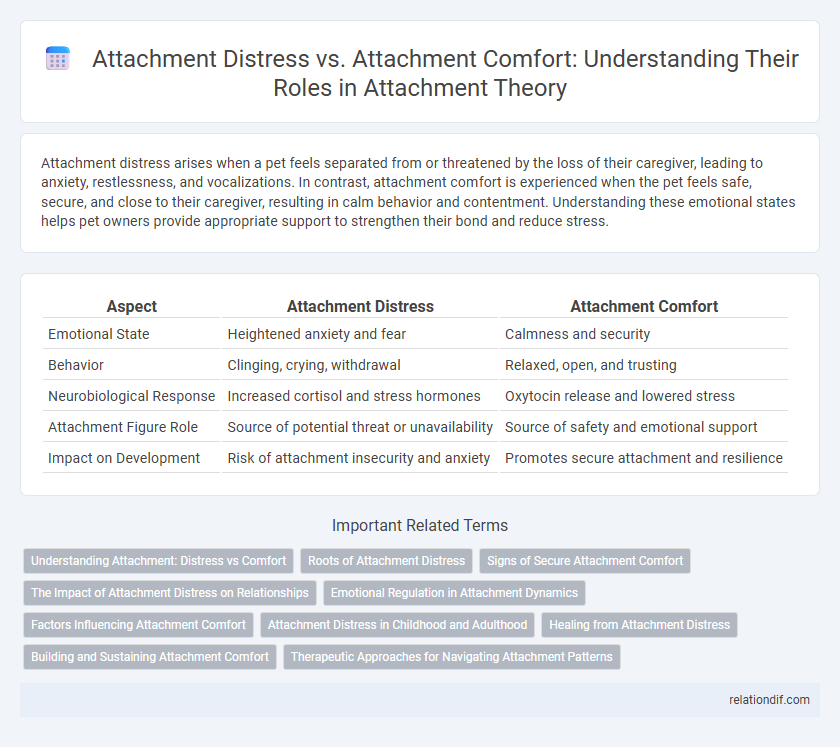Attachment distress arises when a pet feels separated from or threatened by the loss of their caregiver, leading to anxiety, restlessness, and vocalizations. In contrast, attachment comfort is experienced when the pet feels safe, secure, and close to their caregiver, resulting in calm behavior and contentment. Understanding these emotional states helps pet owners provide appropriate support to strengthen their bond and reduce stress.
Table of Comparison
| Aspect | Attachment Distress | Attachment Comfort |
|---|---|---|
| Emotional State | Heightened anxiety and fear | Calmness and security |
| Behavior | Clinging, crying, withdrawal | Relaxed, open, and trusting |
| Neurobiological Response | Increased cortisol and stress hormones | Oxytocin release and lowered stress |
| Attachment Figure Role | Source of potential threat or unavailability | Source of safety and emotional support |
| Impact on Development | Risk of attachment insecurity and anxiety | Promotes secure attachment and resilience |
Understanding Attachment: Distress vs Comfort
Attachment distress activates the brain's alarm system, triggering anxiety, fear, and a drive to seek proximity to the attachment figure for safety. Attachment comfort, conversely, engages the soothing system, promoting feelings of security, calmness, and emotional regulation through the presence or support of a trusted caregiver. Understanding these opposing dynamics is crucial for healthy relational development and effective therapeutic interventions.
Roots of Attachment Distress
Attachment distress originates from early disruptions in caregiver responsiveness, leading to insecurity in the attachment bond. Neurobiological factors, such as heightened amygdala activation and dysregulated cortisol levels, reinforce the emotional pain associated with attachment threats. These roots create a persistent state of hypervigilance and fear of abandonment that undermines attachment comfort.
Signs of Secure Attachment Comfort
Signs of secure attachment comfort include consistent responsiveness, emotional availability, and trust between caregiver and child, fostering a stable sense of safety. The child demonstrates confidence in exploring their environment while seeking comfort during distress, reflecting a balanced attachment bond. Such secure attachment supports healthy emotional regulation and resilience in relationships.
The Impact of Attachment Distress on Relationships
Attachment distress triggers heightened emotional sensitivity and insecurity, often leading to conflicts and reduced trust in relationships. This state impairs effective communication and emotional regulation, making partners less responsive and more reactive. Conversely, attachment comfort fosters security, promoting trust, empathy, and stronger interpersonal bonds that enhance relationship resilience.
Emotional Regulation in Attachment Dynamics
Attachment distress triggers heightened emotional arousal and challenges in emotional regulation, often activating the brain's threat response systems such as the amygdala. In contrast, attachment comfort promotes calming effects via secure base support, enhancing prefrontal cortex activity that facilitates effective emotional regulation. This dynamic interplay between distress and comfort shapes the development of adaptive emotional regulation strategies within attachment relationships.
Factors Influencing Attachment Comfort
Attachment comfort is influenced by consistent caregiver responsiveness, emotional availability, and secure bonding experiences during early childhood. Positive attachment patterns foster emotional regulation, trust, and resilience, mitigating attachment distress typically triggered by neglect or inconsistent caregiving. Neurobiological factors, including oxytocin release and brain development in the limbic system, also play crucial roles in enhancing attachment comfort.
Attachment Distress in Childhood and Adulthood
Attachment distress in childhood manifests as heightened anxiety and fear of abandonment, often triggered by inconsistent caregiving or trauma, leading to difficulties in emotional regulation and social relationships. In adulthood, attachment distress can result in increased vulnerability to stress, relationship instability, and challenges in forming secure interpersonal bonds, frequently linked to unresolved childhood attachment disruptions. Understanding the neurological and psychological impacts of attachment distress is crucial for developing therapeutic interventions that promote healing and secure attachment formation across the lifespan.
Healing from Attachment Distress
Attachment distress triggers heightened anxiety and insecurity stemming from perceived threats to relational bonds, disrupting emotional regulation and interpersonal trust. Healing from attachment distress involves fostering attachment comfort through consistent, empathetic caregiving and therapeutic interventions that rebuild safety and emotional connection. Establishing secure attachment patterns enhances resilience, promotes emotional well-being, and supports healthier relationships.
Building and Sustaining Attachment Comfort
Building and sustaining attachment comfort involves consistent responsiveness and emotional attunement to foster secure bonds, reducing attachment distress characterized by anxiety and fear of abandonment. Strategies centered on empathy, validation, and reliable support enhance emotional safety, promoting resilience in relationships. Long-term attachment comfort strengthens trust and emotional regulation, essential for healthy interpersonal connections.
Therapeutic Approaches for Navigating Attachment Patterns
Therapeutic approaches for navigating attachment patterns emphasize fostering attachment comfort by creating a secure, empathetic environment that contrasts attachment distress experienced in early relationships. Techniques such as Emotionally Focused Therapy (EFT) and Internal Family Systems (IFS) focus on identifying attachment wounds and rebuilding trust through co-regulation and emotional attunement. Incorporating attachment-based interventions enhances clients' ability to regulate emotions, improve relational security, and transform maladaptive attachment distress into adaptive attachment comfort.
Attachment distress vs attachment comfort Infographic

 relationdif.com
relationdif.com